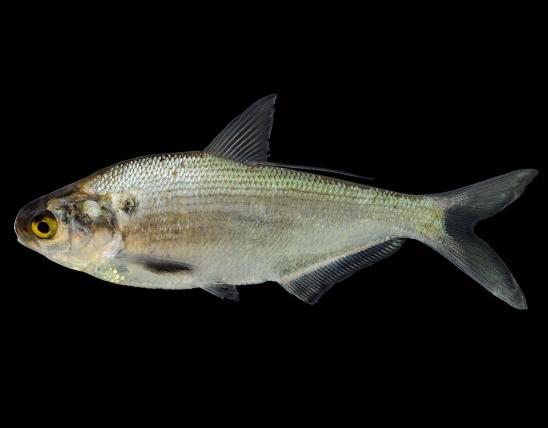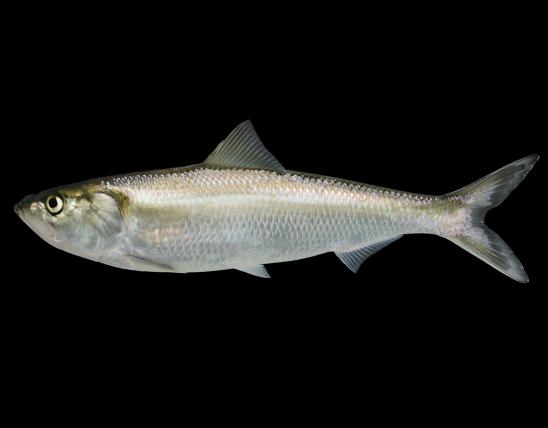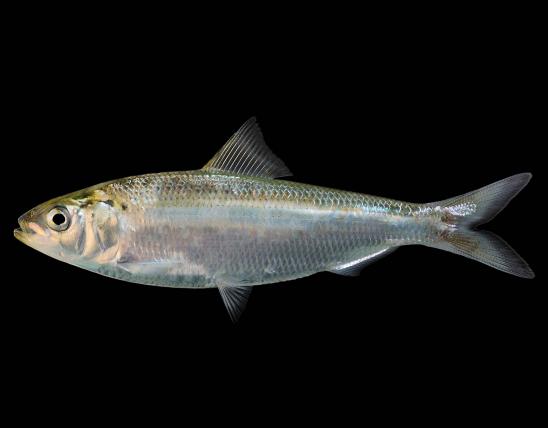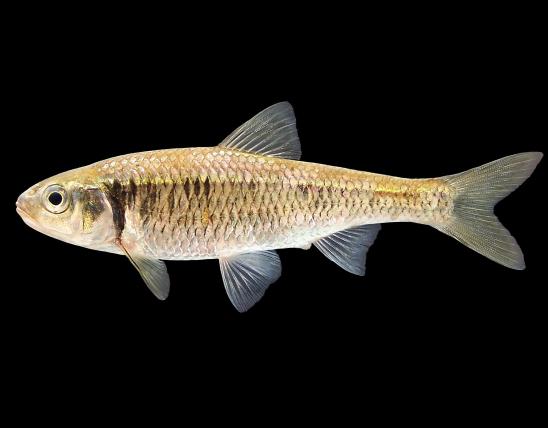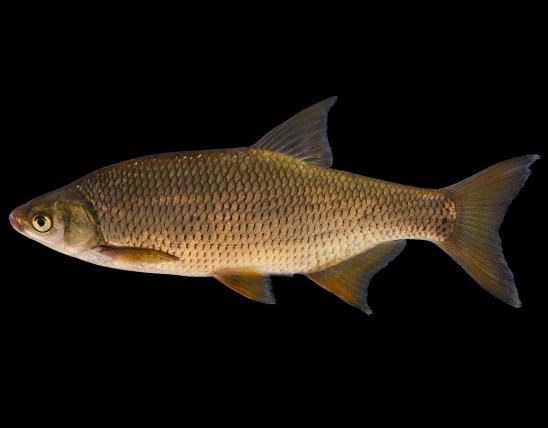
Herrings, as a group, are silvery, flat-sided fish, easily recognized by the row of sharp-edged, spiny scales (or scutes) along the midline of the belly. These scutes are readily apparent when you rub your fingers forward along the fish’s belly.
The threadfin shad is similar to the gizzard shad: both have the last dorsal fin ray elongated into a long, slender filament, they have a dark purplish spot present behind the upper end of the gill opening, and the principal rays of the dorsal fin usually are 14 or fewer. The threadfin shad, however, has the upper jaw projecting well beyond the lower jaw; the lower jaw is only slightly notched at the center; the chin and floor of the mouth is speckled with black pigment; the lateral line scales number about 42–48; and the anal fin rays usually number 20–25. Note also that the threadfin shad, in life colors, has much yellow in all the fins except the dorsal.
Similar species: Four species in the herring family are recorded for Missouri:
- The gizzard shad (D. cepedianum) is most similar to the threadfin shad, but the gizzard shad has the lower jaw not projecting beyond the tip of the snout, and with a deep notch at its center; its anal fin rays usually number 29–35; its lateral line scales number 55 or more; and in life, its tail fin is not yellow; its fins are dusky, without prominent yellow colors.
- Both the skipjack herring and the Alabama shad may be separated from the threadfin shad and gizzard shad by their lack of an elongated, filament-like last dorsal fin ray and their lack of a dark spot behind the upper end of the gill opening. Also, the principal rays of the dorsal fin usually are 16 or more.
Members of the herring family might be mistaken for the mooneye and goldeye (which are in a different family), but herrings have the following key characters: The dorsal fin is far forward of the anal fin. The head is without scales, but the body is covered with thin, smooth-edged (cycloid) scales that are easily dislodged. The lateral line is absent. A small, triangular projection (an axillary process) is present just above the base of the pelvic fin, and the eyes are partly covered by transparent membranes (adipose eyelids).
Habitat and Conservation
The habitat of threadfin shad is much like that of the gizzard shad, except that the threadfin is found more often in waters with a noticeable current. In lakes, the threadfin shad occurs in the upper 5 feet of water, and large numbers congregate below dams in spring and fall.
The threadfin is sensitive to low temperatures, and extensive die-offs are reported at temperatures below 45 F. Survival in Montrose Lake (Henry County) apparently depends on a continuous discharge of warm water by a steam-generating power plant. This might explain why the threadfin has not become established in the Lake of the Ozarks, to which it had access from Montrose Lake.
In the upper Mississippi River, a 1983 survey found the most threadfin shad located near the Portage Des Sioux power plant at Alton, again suggesting that survival of this fish may be dependent on warmwater discharge.
The threadfin was not recorded in Missouri before 1962. Although this could mean it has extended its range into Missouri only in recent decades, it is more likely that the fish was present but overlooked by collectors. In a series of collections made in 1963, the threadfin was more abundant than the gizzard shad in the Mississippi River downstream from the mouth of the Ohio River but did not occur farther upstream than Scott County. By 1980, the threadfin had extended its range upstream 280 miles to Marion County. A single threadfin shad was collected in the Missouri River in Boone County in August 1984, after an extended period of high water.
Food
The threadfin shad is not very selective in its food habits and does not change its diet very much as it increases in size. Microscopic plants and animals that live suspended in the water (that is, phytoplankton and zooplankton) are eaten in about equal quantities and make up the bulk of the diet.
Like the gizzard shad and most other members of the herring family, the threadfin is primarily a filter feeder. Unlike gizzard shad, however, threadfin shad feed primarily in open water, whereas adult gizzard shad are primarily bottom feeders. (Note the difference in their mouth shapes.)
Life Cycle
Spawning begins in the spring when the water temperatures warm to about 70 F and may continue at intervals throughout the warmer months of the year. Spawning has been observed in Missouri reservoirs from mid-April into June.
Spawning activity is confined to the period from dawn to shortly after sunrise. Schools of spawning shad run the shoreline, often actually beaching themselves. One or more females, accompanied by several smaller males, swim erratically near the surface and then suddenly rush toward a log or other submerged object, releasing eggs and sperm as they go. The adhesive eggs stick to submerged objects and hatch in about 3 days. Threadfins that hatch early in the year commonly mature and spawn later in their first summer of life. Few live more than 2 or 3 years. In Bull Shoals Reservoir, females may live up to 4 years and males up to 3.
Human Connections
The herring family is primarily marine and includes some of the most valuable food fishes in the sea. Of the four members of the herring family in Missouri, none are commonly used as food for people. Only the skipjack herring is taken on hook and line.
Like the gizzard shad, the threadfin shad is taken on hook and line only by accident; its soft, tasteless flesh is of little value as food for people.
Threadfin shad have been introduced to waters in the northern United States, with the idea that they will serve as a forage food for game fish such as basses and catfishes. However, in late summer when dissolved oxygen diminishes, and in fall when the water temperature falls below 45 F, there can be huge die-offs of the threadfins. The dead fishes are washed ashore in windrows, stinking to high heaven. Fish- and carrion-eating birds and mammals have an unnatural heyday, while people nearby hold their noses or avoid the place altogether. It can’t be good for tourism.
Ecosystem Connections
The herring family is primarily marine. Many herring and shad are anadromous, spending most of their adult life in saltwater but ascending freshwater streams to spawn. Of Missouri’s species, three out of four (the threadfin and gizzard shads, and the skipjack herring) are not anadromous; they can complete their entire life cycle in freshwater. The Alabama shad, however, must move between salt and freshwater to complete its life cycle.
Where threadfin shad have been introduced in waters where they are not native, there is concern that their large numbers of plankton-eating young might outcompete the larvae of native minnows, suckers, sunfishes, and other fishes.
Shad form a short, efficient link in the food chain between the tiniest organisms (such as algae and zooplankton) and larger fish as well as many other fish-eating animals: herons, seagulls, cormorants, watersnakes, raccoons, and many, many more.
The pointed scutes along the bottom keel of shad and other herring are one reason many fish-eating predators flip a fish around before swallowing, so that the shad goes down headfirst. In the process of flipping the shad around, the predator might accidentally drop the shad, and the shad might escape. In this way, the scutes offer a survival advantage to the shad.
Hungry schools of plankton-feeding shad help to reduce numbers of microscopic animals, including larval insects, which may also have a very high reproductive capacity.
























